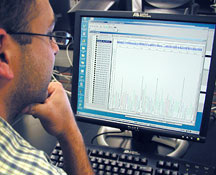

New Instrument Offers Fast, High Quality Results
By Mika Ono
Science has come a long way since the time when Gregory Mendel grew pea plants in the garden of his Augustinian monastery. Over the last 150 years, science has grown hand-in-hand with technical innovations—computers, electron microscopy, and recombinant DNA technology.
With this in mind, The Scripps Research Institute's Center for Nucleic Acids Research has acquired a powerful new DNA sequencer to serve investigators at the institute.
"The new sequencer is a cutting-edge instrument," says Phil Ordoukhanian, director of the nucleic acids core facility. " It offers some of the best technology on the market."
The machine, a capillary electrophoresis 3730 DNA Analyzer from Applied Biosystems, Inc. (ABI), improves on older models by providing much faster run times, increased sensitivity, and higher quality data. For Scripps Research scientists, this means if they drop off samples by 2 PM, their data will be ready by noon the following day. Runs may be successful with less or lower-quality sample. And gel lane tracking errors typical with the older technology are no longer a concern.
While the instrument itself was a significant investment for the institute, over the long-term it will save money through lower reagent and consumable costs.
Starting on Wednesday, February 2, the 3730 DNA sequencer will act as the primary instrument at the nucleic acids core facility. The three older machines, the ABI 377 DNA sequencer, ABI 3700 DNA analyzer, and ABI 3100 DNA analyzer, will be kept as backup.
In conjunction with the transition to the new instrument, Ordoukhanian is introducing methodology at the facility to streamline runs, including an improved protocol for removing dye terminators from cycle sequencing reactions.
"The core facility has a lot to offer Scripps Research scientists," Ordoukhanian says, "including on-campus pickup at three locations, competitive pricing, and now a 24-hour turnaround time."
Ordoukhanian himself is familiar with the demands of life in the laboratory. A graduate of University of Missouri-St. Louis, he then went on to receive his Ph.D. from Washington University in St. Louis, and spent three years as a postdoc in the Joyce laboratory at Scripps Research. There, he worked on in vitro evolution of nucleic acid enzymes before moving to direct the core facility in 2001.
The core facility, which runs between 25,000 and 30,000 sequences every year, operates on a cost-recovery basis for Scripps Research scientists. In addition to Ordoukhanian, staff includes Research Assistant John Shimashita, Research Assistant Michael Stirk, Lab Assistant Francis Le, and Administrative Assistant Nina Tung.
In addition to DNA sequencing, the facility offers RNA and modified DNA synthesis and DNA fluorescent fragment analysis.
"Since technology is always evolving, our scientists' needs are a moving target," notes Ordoukhanian. "I'm always open to discussions about new ways we can help and new services we could offer."
For more information, contact Ordoukhanian, at x4-9941 or e-mail philo@scripps.edu, or see the facility's web page at: http://www.scripps.edu/corefac/nucleicacids/.
Send comments to: mikaono[at]scripps.edu


Phil Ordoukhanian directs the nucleic acids core facility, which runs between 25,000 and 30,000 sequences for Scripps Research investigators every year. Photos by Kevin Fung.
